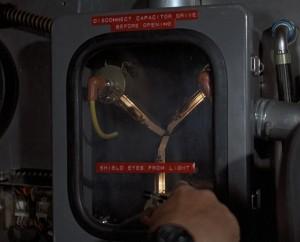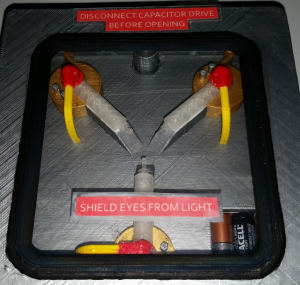 There is probably no piece of fictitious technology more well known than the Flux Capacitor seen in the Back to the Future trilogy. If you say the words “Flux Capacitor” to anyone, chances are that person will know exactly what you’re talking about, and probably even quote the movie. The small box with a Y-shaped trio of lights is described as what makes Doc Brown’s iconic DeLorean time machine work, but of course he doesn’t really explain how. And while both ‘flux’ and ‘capacitor’ are two words often associated with electronics, they are never used in conjunction with each other. So much like “Dilithium Crystals” from Star Trek, fans have needed to create their own science to fill in the gaps.
There is probably no piece of fictitious technology more well known than the Flux Capacitor seen in the Back to the Future trilogy. If you say the words “Flux Capacitor” to anyone, chances are that person will know exactly what you’re talking about, and probably even quote the movie. The small box with a Y-shaped trio of lights is described as what makes Doc Brown’s iconic DeLorean time machine work, but of course he doesn’t really explain how. And while both ‘flux’ and ‘capacitor’ are two words often associated with electronics, they are never used in conjunction with each other. So much like “Dilithium Crystals” from Star Trek, fans have needed to create their own science to fill in the gaps.
And it was the very iconic nature of the movie’s Flux Capacitor that inspired Thingiverse user and host of YouTube’s Chaos Core Tech to create his own 3D printable version. By trade, Chaos Core Tech’s Garrett Kearney is a programmer but he’s always found himself interested in electronics and how they work. While trying to create his own electronic projects he became frustrated with the lack of options available to build attractive and usable cases and boxes. Usually there is an option between plain black plastic box or plain wooden box, and neither was especially attractive or what Garrett was looking for. But all of that changed when he managed to save up some cash and get himself his own Robo3D 3D printer.
After breaking his new Robo3D in with a few test prints, Garrett got right to work on his first project, a light-up Flux Capacitor replica. He turned to Google for some high-quality reference photos, which he found in abundance, and turned to Tinkercad to start designing. Garrett considered both accuracy and ease of printing while designing, so none of the parts will require support material or rafting and should fit together quite snugly. He did do a few test prints to make sure that he had sized the battery slots correctly, and he performed some clear filament tests to make sure that he could print something that would diffuse the light properly.
Despite the amount of 3D printing involved, this is actually a pretty quick 3D printing project. The main body contains four parts taking about six hours to print with a 0.3mm layer height. He also printed the inside cover and the capacitor’s lid with a 0.3mm layer height, each taking about an hour. He finished his design off with three clear parts and three smaller inside details that took him between twenty and thirty minutes to print each. He printed the smaller parts with a layer resolution of 0.1mm because they were so small and needed to have a definable curve on them. All of the Flux Capacitors parts are completely 3D printed, with the only exception being the electronic components.
“I created a slot for 3 AAA batteries to be inserted, a rocker switch (to turn the device on and off), and 3 LEDs. The LEDs shine really nicely through the clear PLA. And I left the battery slot uncovered so the batteries can be easily replaced. And there’s plenty of room underneath the electronics cover for people to add to it if they build their own. It’d be very easy to add a timer chip and make the LEDs flash in different patterns,” Garrett told us via email.
While there are some tricky parts of this build because of the electronics, overall the 3D Printed Flux Capacitor is a great project for beginners, and a no brainer for fans of the Back to the Future movies. Not only are the parts pretty straightforward, but Garrett has documented his build and walks anyone who wants to create their own Flux Capacitor through the entire process with a series of YouTube tutorials.
Let us know what you think of this project over on our 3D Printed Flux Capacitor forum at 3DPB.com. Here is part one of the 3D Printed Flux Capacitor YouTube tutorials:
Subscribe to Our Email Newsletter
Stay up-to-date on all the latest news from the 3D printing industry and receive information and offers from third party vendors.
You May Also Like
3D Printing News Unpeeled: A $3000 SLS System, Construction Subsidies and Parameters
The Housing Affordability Crisis is one of Canadian President Trudeau’s biggest issues. Now the government has made subsidies available, including scaling new technologies, 3D printed housing and libraries of reapproved...
“Bundled Light” Enables High Quality Plastic 3D Printing from LEAM
Naturally, we expect current 3D printing methods to continuously improve, but it continues to do so in the most surprising ways. The latest development comes from LEAM, a startup spun...
Each to Their Own: Exploring Creality’s Latest Ender Trio as the Company Strengthens Its Commitment to 3D Printing Advocacy
Creality has reaffirmed its commitment to promoting 3D printing. The launch of the Ender-3 V3 SE, Ender-3 V3 KE, and Ender-3 V3 showcases the company’s dedication to catering to diverse...
3D Printing News Briefs, March 23, 2024: AM in the US Coast Guard, Navy, & More
In today’s 3D Printing News Briefs, we’re discussing the use of 3D printing in various branches of the military, including the U.S. Coast Guard, the U.S. Navy, and the German...
































